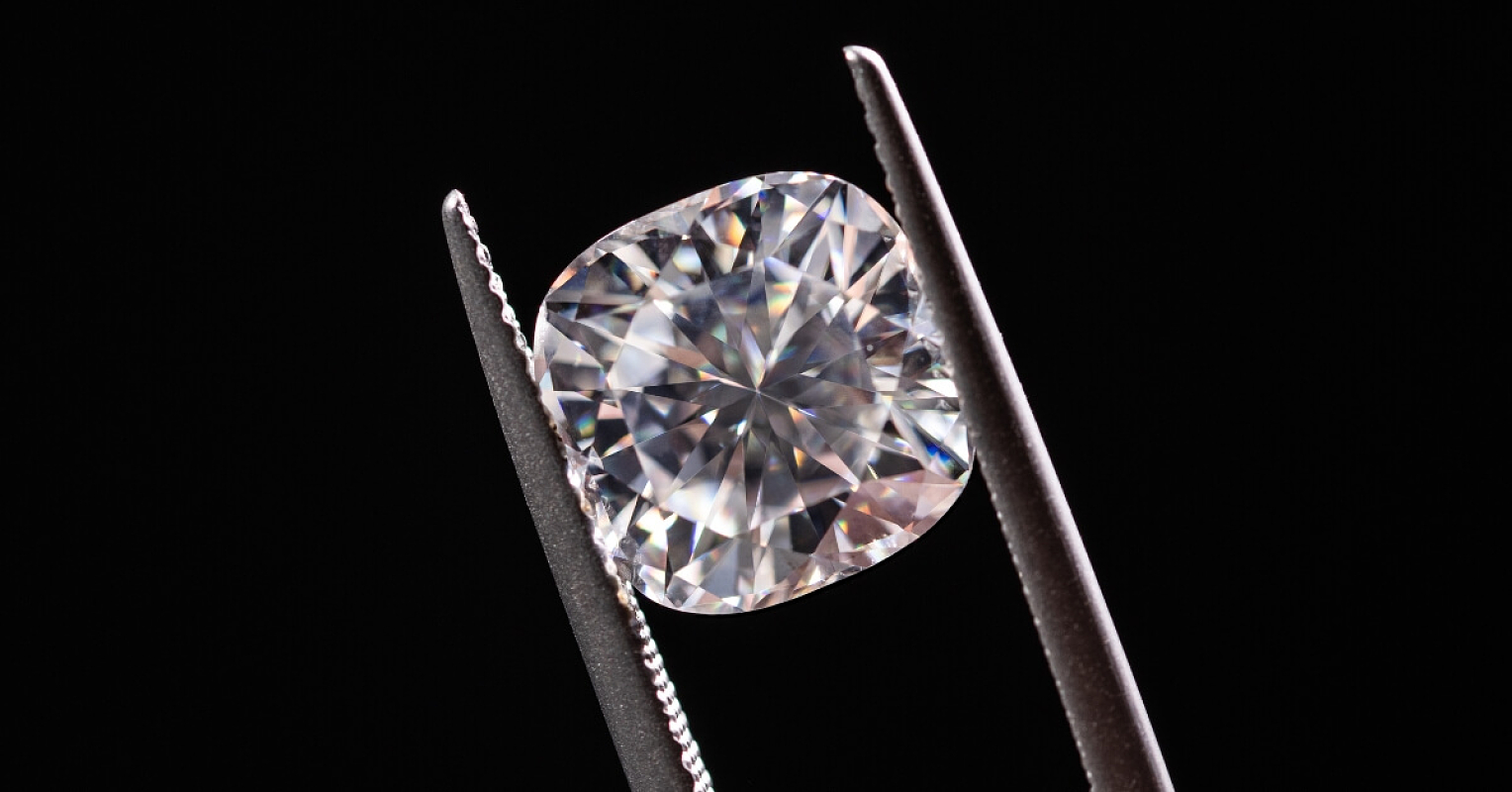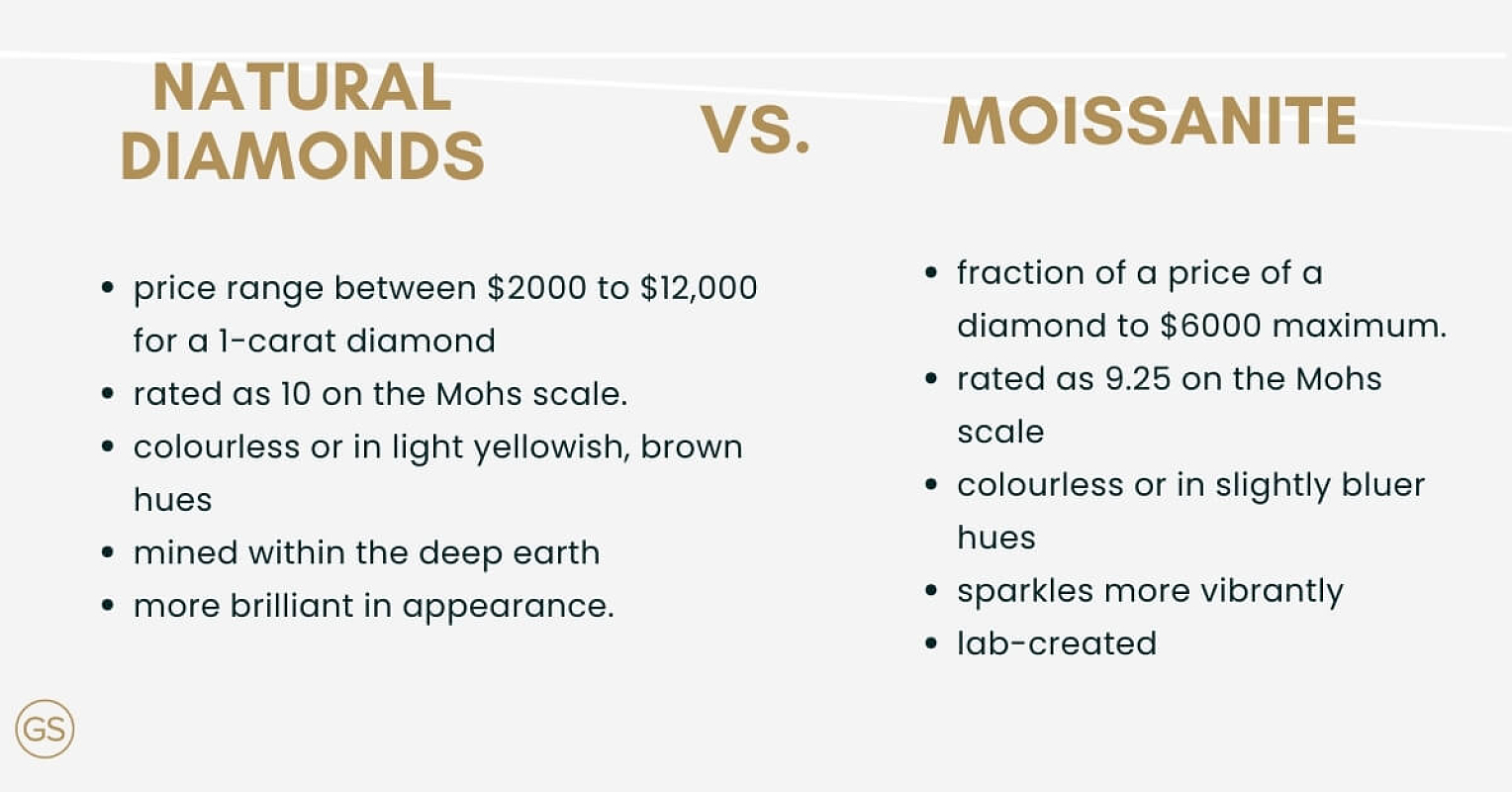
Natural diamonds have long been the traditional choice for engagement rings due to their signature shine and incredible durability, but the rise of moissanite as an affordable alternative has some buyers questioning the key differences between the two precious stones.
If you’re wondering about what sets natural diamonds apart from moissanite, we’ve got the answers for you. Read on for a detailed comparison of natural diamonds and moissanite gems.
In case you’re not already aware, moissanite is a mineral that bears some resemblance to the appearance of diamonds. Moissanite is composed of silicon carbide and can be found in fragments of meteorites as well as in certain geological formations on Earth.
There are other distinct characteristics of moissanite that we’ve included in the comparison below.

Before we proceed, it should be made clear to potential buyers that moissanite, while bearing some similarity to natural diamonds, is a vastly different type of gemstone. The comparisons made below are to help buyers look for the right choice of gemstone that fits their personal preferences and budget.
Natural diamonds are prized for their rarity and organic beauty, and their prices are a reflection of that. While it can be difficult to estimate the price of a diamond due to the factors that affect its quality, price values across the gemstone marketplace generally fall between the range of $2000 to $12,000 for a 1-carat diamond. In comparison, a moissanite stone with the same carat weight $2000 to $12,000 for a 1-carat diamond of this price range — going up to a maximum of $600.
With a reputation as the hardest material in the world, natural diamonds are rated at the maximum of 10 on the Mohs scale. Only other diamond materials are able to scratch another diamond.
Moissanite has a slightly lower value of 9.25 on the same scale, meaning that in terms of hardness and durability, moissanite is more likely to sustain damage from contact with other harder substances.
Modern options for moissanite are mostly available in the same colours as colourless natural diamonds. Moissanite tends to feature a slightly bluer hues compared to natural diamonds, which mainly come in light yellowish or brown hues, but it’s also not uncommon to see moissanite appear in green or yellow shades.
Colourlessness is a highly sought-after trait for both types of gemstones, and it’s also interesting to know that moissanite gems are rated on the same colour scale (D-I ratings) used for natural diamonds.
Natural diamonds are mined and uncovered from deposits deep within the earth. For some, this is a big part of the value of the natural diamonds — knowing that something is naturally made adds to its uniqueness and novelty.
Moissanite is almost always lab-created, this is in part due to their rarity in natural environments, as well as how easy they are to create using artificial methods. This leads to it having a more “common” value, especially when compared to natural diamonds.
Another key difference between natural diamonds and moissanite involves the way they reflect light, more specifically their brilliance and fire. Natural diamonds are more brilliant — they reflect white light better than moissanite. Moissanite, on the other hand, is known for having a stronger “fire", which refers to the amount of coloured light it reflects.
As a result, diamonds tend to look “brighter”, while moissanite sparkles more vibrantly under most light sources. This distinct difference in the way they reflect light is also the most recognisable way to tell the difference between natural diamonds and moissanite.

Yes. This difference is quite obvious, even to those with no specialised training in jewellery. As mentioned above, the stark difference is in how they reflect light — moissanite tends to have a more colourful dispersion of light often referred to as “rainbow hues”, while diamonds will feature a purer and white shine.
Cubic zirconia is another “diamond-like” gemstone that is even more affordable than moissanite. The difference in value is most certainly reflected in the quality of the gemstone, however, with cubic zirconia being less durable (8.5 Mohs) and offering significantly less fire and brilliance as compared to moissanite. It’s typically not considered to be a quality gemstone to be used in most jewellery.
Moissanite suffers from a rather poor resale value due to its lower popularity in the gemstone market as well as a lack of demand. Coupled with the low initial cost, moissanite does not hold value well over time. It’s not advised for buyers to purchase moissanite gems with the intention of investment.
The high cost of natural diamonds is a big hurdle for many buyers who don’t want to sacrifice on quality when it comes to buying a beautiful gemstone. For these buyers, lab-grown diamonds may be a good alternative for buying a diamond that meets their personal preferences and budget.
Lab grown diamonds are 100% real diamonds, with the only difference being that they were developed with specialised equipment, albeit under similar conditions as their natural counterparts. Costing about 60% to 85% less than natural ones, lab-grown diamonds are a cost-effective alternative to get a real diamond without blowing the budget.
At GS Diamonds, we stock a fine range of diamonds both natural and lab-grown. If you are looking for a diamond to complete a custom engagement ring or wedding ring, our expert jewellers can help you find the right stone and setting. Browse our online store today or head down to our diamond showrooms in Melbourne and Sydney!